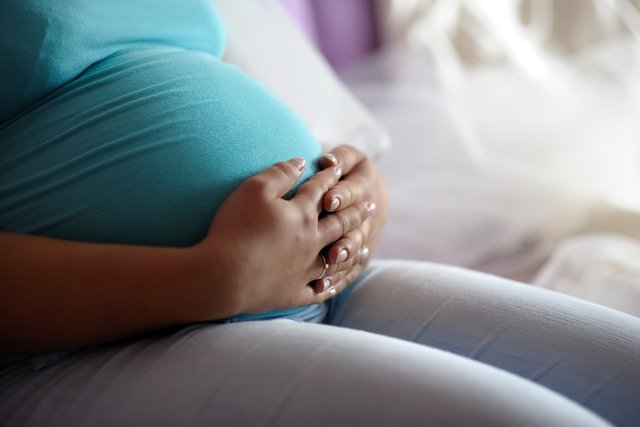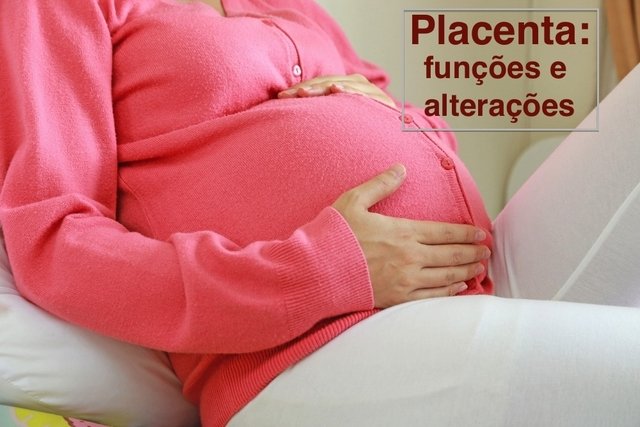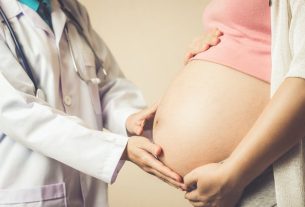Placenta is a maternal-fetal organ, formed gradually during the first three months of pregnancy, whose main function is to provide nutrients and oxygen to the baby, in addition to eliminating waste and carbon dioxide, and producing essential hormones for this period.
After the baby is born, the placenta is naturally eliminated, which can be helped by the obstetrician to confirm that there are no placental remains inside the uterus, which could cause postpartum complications, such as vaginal bleeding or endometriosis, for example.
The placenta is essential for the baby’s development, however, during pregnancy, it is possible for it to undergo some changes that could compromise the pregnancy. Therefore, it is important that pregnant women carry out all prenatal consultations to ensure that their health and that of the baby are as expected and so that, if necessary, the doctor can give some guidance to avoid complications.

Functions of the placenta
The main functions of the placenta are:
1. Provide nutrients and oxygen to the baby
The placenta is responsible for maternal-fetal exchanges during pregnancy, providing nutrients, water, electrolytes and oxygen to the baby.
These nutrients and oxygen reach the baby through the umbilical cord, which is connected to the placenta, allowing the fetus to develop properly during pregnancy.
2. Eliminate waste
In the same way that the placenta provides oxygen and nutrients to the baby, it also removes waste produced by the fetus, such as carbon dioxide, water, urea, hormones and other waste.
3. Produce hormones
The placenta produces essential hormones for pregnancy, such as human chorionic gonadotropin, HCG, which in turn stimulates the production of progesterone by the cells of the corpus luteum to maintain the pregnancy.
HCG is a hormone that has important functions, such as promoting the formation of blood vessels in the uterus, blocking the action of the immune system on placental cells, promoting uterine growth and preventing uterine contractions during pregnancy, for example.
4. Provide immune protection to the baby
The placenta is able to metabolize substances and protect the baby against infections.
Furthermore, the placenta regulates the maternal immune system to prevent the immune system from attacking the baby as if it were foreign to the body.
5. Promote healthy environment for baby’s development
The placenta is responsible for releasing several hormones to sustain the pregnancy and promote the healthy development of the baby.
One of these hormones is placental growth factor, which promotes cardiovascular adaptations in the pregnant woman’s body, and the development and maturity of the baby.
Another hormone produced is human chorionic somatomamotropin (HCS), which promotes the development of the pregnant woman’s mammary glands for future breastfeeding, as well as decreasing insulin sensitivity, so that maternal glucose is more available to the baby.
The placenta is essential for the baby’s development, however, during pregnancy, it can undergo changes, bringing risks and complications for the mother and the baby.
How the placenta is formed
The formation of the placenta begins after implantation of the embryo in the uterus, which occurs between the 7th and 12th days after fertilization, comprising a fetal part, called chorionic villi, and a maternal part, the decidua basalis.
Throughout the first trimester the placenta continues to form and after this period its growth occurs.
At around 16 weeks of gestation, the placenta and the baby are the same size, and by the end of pregnancy the baby is about 6 times heavier than the placenta.
The placenta is eliminated at the time of birth, whether cesarean or normal. In a natural birth, the complete delivery of the placenta can take 30 minutes to 1 hour, while in a cesarean section, the doctor removes the placenta in the same way as he removed the baby.
During the removal of the placenta, whether normally or with medical help, it is common to experience mild cramps, like those during the menstrual period, and this happens because the uterus is returning to its pre-pregnancy size.
Most common placental changes
Some changes that can affect the placenta are:
1. Placenta previa
Placenta previa, also called low placenta, occurs when the placenta develops partially or completely in the lower region of the uterus, covering the cervix, which is the place where the baby passes, and can prevent normal birth.
Placenta previa is common at the beginning of pregnancy and is not very worrying, as with the growth of the uterus throughout the pregnancy, it is possible for the placenta to be displaced to the correct location, allowing for a normal birth.
However, when placenta previa persists until the third trimester of pregnancy, a cesarean section may be necessary, as in this case it is not possible to have a natural birth. This change is more common in women who are pregnant with twins, who have uterine scars from previous surgeries, who are over 35 years old or who have previously had placenta previa.
The occurrence of a low placenta can be detected through ultrasound during prenatal care, in which the doctor checks the position of the placenta throughout the development of the pregnancy.
If placenta previa is confirmed, it is important that the woman seeks medical attention whenever she experiences vaginal bleeding, as this way the obstetrician will be able to monitor, identify the cause of the bleeding and reduce the risk of premature birth and complications during pregnancy. See how placenta previa is diagnosed and treated.
Make an appointment with the obstetrician in the nearest region:
Taking care of your health has never been easier!
2. Placental abruption
Placental abruption corresponds to a situation in which the placenta is separated from the wall of the uterus, resulting in vaginal bleeding and very strong abdominal cramps. Due to the separation of the placenta, there is a decrease in the amount of nutrients and oxygen sent to the baby, interfering with its development.
Placental abruption can happen more frequently from the 20th week of pregnancy and can result in premature birth. Find out what to do in case of placental abruption.
3. Placenta accreta
Placenta accreta is a situation in which the placenta has an abnormal attachment to the uterus, resisting its exit during childbirth. This problem can cause hemorrhages requiring blood transfusions and, in the most serious cases, complete removal of the uterus, in addition to putting the woman’s life at risk.
4. Calcified or aged placenta
It is a normal process and is related to the degree of development of the placenta. This change is only a problem if the placenta is classified as grade III before 34 weeks, as it can cause a decrease in the fetal growth rate. In general, the woman does not present symptoms and this problem is identified by the doctor during routine ultrasounds.
Learn more about the degrees of maturation of the placenta.
5. Placental infarction or placental thrombosis
Placental infarction occurs when there is blockage of a blood vessel in the placenta, which characterizes thrombosis and results in a decrease in the amount of blood that goes to the baby. Although this complication can cause miscarriages, it may also not cause problems with the pregnancy and go unnoticed. Check out what to do in case of placental thrombosis.
6. Bilobed placenta
Bilobed placenta occurs when the placenta is divided into two of the same size and which are connected by placental tissue. This change must be monitored carefully by the medical team, as there is a greater risk of rupture of the vessels between the two parts of the placenta during normal birth.
7. Sucenturiada placenta
Sucenturiate placenta is the division of the placenta into two or more parts of different sizes, usually smaller than the main placenta. The connection between the parts occurs only through vessels, with no placental tissue. The main risk of this change is the failure to completely expel all placental parts after birth, increasing the risk of maternal hemorrhage and infection.
Can you eat the placenta after giving birth?
Eating the placenta after birth, called placentophagy, has been linked to a number of benefits, such as preventing postpartum depression, promoting baby weight gain or increasing the concentration of lactose and proteins in breast milk and the production of milk. Understand better how eating the placenta could be good.
However, Eating the placenta after birth, whether raw, roasted, cooked, dehydrated, in vitamins, tinctures or capsules, is discouraged by doctors and is not approved by the Brazilian Federation of Gynecology and Obstetrics (Febrasgo), as there are no studies that prove its benefits. benefits.
Additionally, eating the placenta after birth can increase the risk of bacterial infections, such as Streptococcus type B, in women and babies, or even other infections present during pregnancy, such as syphilis, hepatitis A, Zika or HIV.

Sign up for our newsletter and stay up to date with exclusive news
that can transform your routine!
Warning: Undefined array key "title" in /home/storelat/public_html/wp-content/plugins/link-whisper-premium/templates/frontend/related-posts.php on line 12
Warning: Undefined array key "title_tag" in /home/storelat/public_html/wp-content/plugins/link-whisper-premium/templates/frontend/related-posts.php on line 13




